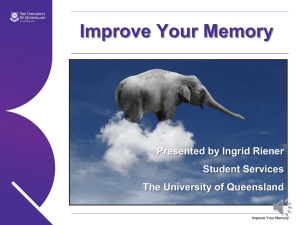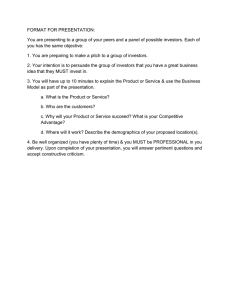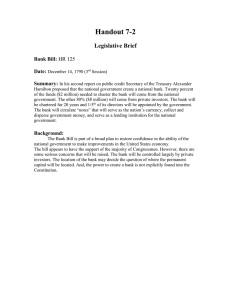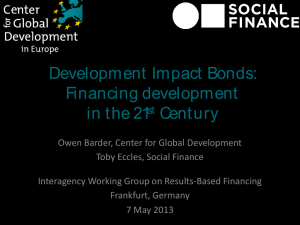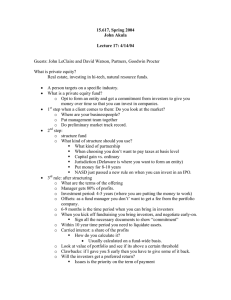the effects of information ordering on investor
advertisement
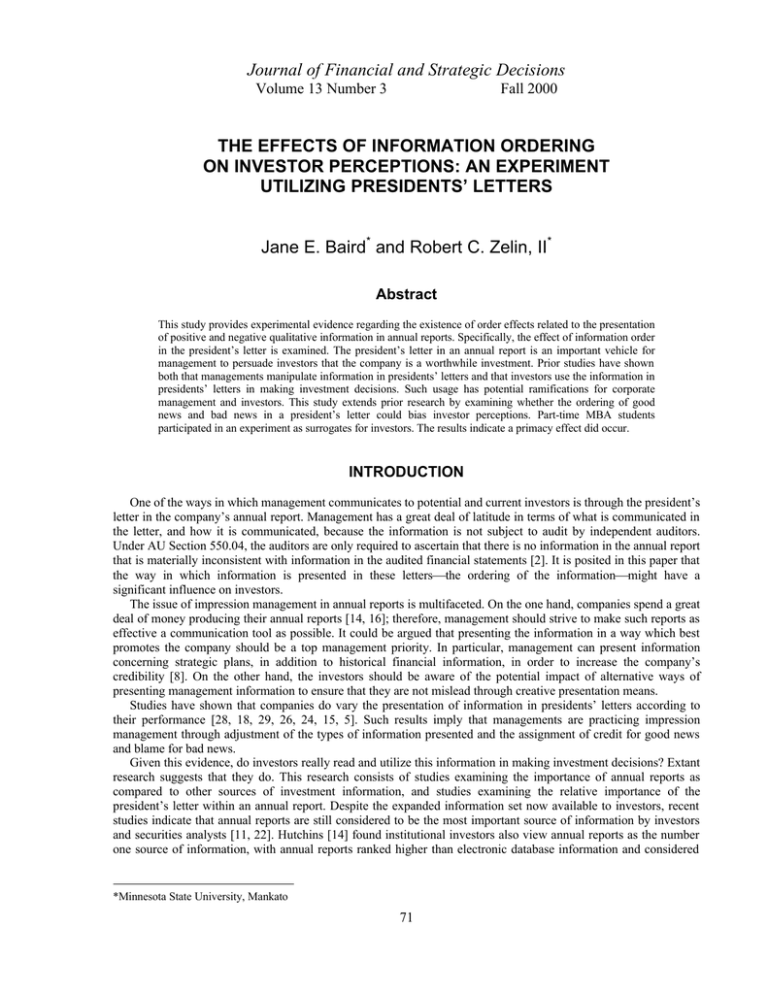
Journal of Financial and Strategic Decisions Volume 13 Number 3 Fall 2000 THE EFFECTS OF INFORMATION ORDERING ON INVESTOR PERCEPTIONS: AN EXPERIMENT UTILIZING PRESIDENTS’ LETTERS Jane E. Baird* and Robert C. Zelin, II* Abstract This study provides experimental evidence regarding the existence of order effects related to the presentation of positive and negative qualitative information in annual reports. Specifically, the effect of information order in the president’s letter is examined. The president’s letter in an annual report is an important vehicle for management to persuade investors that the company is a worthwhile investment. Prior studies have shown both that managements manipulate information in presidents’ letters and that investors use the information in presidents’ letters in making investment decisions. Such usage has potential ramifications for corporate management and investors. This study extends prior research by examining whether the ordering of good news and bad news in a president’s letter could bias investor perceptions. Part-time MBA students participated in an experiment as surrogates for investors. The results indicate a primacy effect did occur. INTRODUCTION One of the ways in which management communicates to potential and current investors is through the president’s letter in the company’s annual report. Management has a great deal of latitude in terms of what is communicated in the letter, and how it is communicated, because the information is not subject to audit by independent auditors. Under AU Section 550.04, the auditors are only required to ascertain that there is no information in the annual report that is materially inconsistent with information in the audited financial statements [2]. It is posited in this paper that the way in which information is presented in these lettersthe ordering of the informationmight have a significant influence on investors. The issue of impression management in annual reports is multifaceted. On the one hand, companies spend a great deal of money producing their annual reports [14, 16]; therefore, management should strive to make such reports as effective a communication tool as possible. It could be argued that presenting the information in a way which best promotes the company should be a top management priority. In particular, management can present information concerning strategic plans, in addition to historical financial information, in order to increase the company’s credibility [8]. On the other hand, the investors should be aware of the potential impact of alternative ways of presenting management information to ensure that they are not mislead through creative presentation means. Studies have shown that companies do vary the presentation of information in presidents’ letters according to their performance [28, 18, 29, 26, 24, 15, 5]. Such results imply that managements are practicing impression management through adjustment of the types of information presented and the assignment of credit for good news and blame for bad news. Given this evidence, do investors really read and utilize this information in making investment decisions? Extant research suggests that they do. This research consists of studies examining the importance of annual reports as compared to other sources of investment information, and studies examining the relative importance of the president’s letter within an annual report. Despite the expanded information set now available to investors, recent studies indicate that annual reports are still considered to be the most important source of information by investors and securities analysts [11, 22]. Hutchins [14] found institutional investors also view annual reports as the number one source of information, with annual reports ranked higher than electronic database information and considered *Minnesota State University, Mankato 71 72 Journal of Financial and Strategic Decisions even more important than in the past. Fulkerson [11] reports that 80 percent of portfolio managers, 75 percent of securities analysts, and 70 percent of individual investors use annual reports in making investment decisions. In regard to the use of presidents’ letters specifically, the evidence indicates both that financial statement users utilize information contained in the letters and the letters contain useful information. Fulkerson [11] indicates 67 percent of portfolio managers and 28 percent of individual investors show a high level of interest in presidents’ letters for investment information. Abrahamson and Amir [1] found that market participants use the president’s letter information to assess companies’ quality of earnings. Kaplan et al. [17] provided experimental evidence that the president’s letter had a significant impact on subjects’ perceptions of future expectations for a company and their likelihood of tendering a proxy to management, buying more stock in the company, and holding onto the stock already owned. These reports are consistent with earlier studies reporting that the president’s letter is one of the most widely read sections of the annual report [7, 33, 20, 19], and that the information gleaned from those letters is important in influencing investor decisions [21, 3, 34, 33] Despite the potential for bias in presidents’ letters [12], researchers have found that information in the letters can be useful in predicting future company performance [1, 25, 30, 10, 29]. Tennyson et al. [30] found that the qualitative information in presidents’ letters and the management discussion and analysis provided useful information in predicting bankruptcy, over and above that provided by the financial information. Additionally, investors are demanding more future-oriented and qualitative information in annual reports [6, 9], and are making extensive use of such information [23]. Since companies typically have both negative and positive information to convey in annual reports, and such communications appear to be important to investor decisions, it is critical to explore how the presentation of such information might influence investors. One aspect of such presentation which has not been examined is the ordering of the positive and negative components of the president’s message. This topic is important to various stakeholders because of the possibility that investor impressions might be influenced by information ordering as well as information content. For corporate management, there are potential opportunities to maximize the benefits of strategic communications; for investors, there is a potential need for increased awareness of such strategies. Therefore, the purpose of this study was to determine if the ordering of positive and negative information about a company in the president’s letter within its annual report could influence investor perceptions of that company. In the next section, a model predicting order effects is presented. An experiment is then described in which MBA students evaluated a hypothetical company based on a president’s letter. The description is followed by a discussion of the results and their implications. ORDER EFFECTS: THE BELIEF-ADJUSTMENT MODEL A plethora of research has been reported concerning possible order effects in information presentation. That is, when more than one piece of information is presented, and that information is a mix of positive and negative or varies in degree of positivity or negativity, does the ordering of the information influence perceptions and decisions? Is all information equally utilized, or are individuals more influenced by the first information (primacy effect) or the last information (recency effect) received? The Belief-Adjustment Model [13] was chosen for this experiment due to the strong empirical support reported by several authors, including Tubbs et al. [31], Hogarth and Einhorn [13], Tubbs et al. [32], and Ashton and Ashton [4]. The predicted order effects according to the Belief-Adjustment Model are summarized in Table 1. The model predicts that whether a primacy effect, recency effect, or no order effect occurs will depend on certain characteristics of the information set: (1) the complexity of the information and task − Two categories of complexity are considered: complex (a large amount of information or unfamiliar stimuli) and simple (familiar tasks and small amounts of information). (2) the length of the information set − Two categories are used: short (12 or fewer items) and long (more than 12 items). (3) the consistency or inconsistency of the information components − Information is consistent if it is all positive or all negative, but inconsistent if it includes both positive and negative components. (4) the response mode employed to process the information − The mode involves whether or not the required response is an estimation (i.e. probability assessment) or an evaluation (i.e. like or dislike), and whether or not such responses are made just once after all information is received (End of Sequence response), or revised after each piece of information (Step by Step response). 73 The Effects Of Information Ordering On Investor Perceptions The model predicts when information is consistent, order effects will be present only when a long series of information is presented (primacy), or when the End of Sequence response mode is used in a short, simple series (primacy). When information is mixed, the model predicts primacy effects for short, simple information sets combined with an End of Sequence response mode and for all long information sets. The model predicts recency effects for short, complex information sets and short, simple, Step-By-Step situations. TABLE 1 Expected Order Effects According To Belief Adjustment Model Simple End of Sequence Complex Step by Step End of Sequence Step by Step Mixed Information Set: Short Primacy* Recency Recency Recency Long Primacy Primacy Primacy Primacy Consistent Information Set: Short Primacy None None None Long Primacy Primacy Primacy Primacy *The president’s letter used in this study represented this category. Hypotheses The president’s letter utilized in this experiment contained 12 sentences and therefore, is considered a short information series under the Belief Adjustment Model. The task was one which should have been familiar to the subjects due to their prior investment experience and their coursework. Therefore, according to the Belief Adjustment Model, this would be considered a short, simple information series. Since the letter contained both positive and negative pieces of information, it was considered a mixed information set. The subjects were asked to respond in an End of Sequence mode, making their evaluations after the entire letter was read. According to the Belief-Adjustment Model, for a mixed, short, simple information set and an End-of-Sequence response mode, a primacy effect should be observed. Therefore, the group of subjects receiving the letter with all the positive information presented first (Positive Group) should form a more favorable impression of the company than the group presented with all the negative information first (Negative Group). Based on this theory and the experimental design employed in this study, the following hypotheses were generated: H1: Subjects receiving all positive information first (positive group) will evaluate the company’s past performance more positively than will subjects receiving all negative information first (negative group). H2: Subjects receiving all positive information first (positive group) will evaluate the company’s future potential more positively than will subjects receiving all negative information first (negative group). METHOD The Task A hypothetical president’s letter was constructed utilizing positive and negative pieces of information obtained from several actual president’s letters in annual reports. Two versions of the letter were constructed, both including the same statements, but with the ordering of the positive and negative components varied. The first version, hereafter termed “positive,” included all the positive information about the company first, followed by the negative information. The second version, hereafter termed “negative,” included all the negative information first, followed by the positive information. 74 Journal of Financial and Strategic Decisions There were six positive statements and six negative statements about the company in the letter. The “positive” form of the letter is shown in Appendix A. In this version of the letter, all of the positive statements are in the first paragraph with the negative statements in the second paragraph. The “negative” version was identical except that the ordering of the paragraphs was reversed. A questionnaire was developed to elicit perceptions of the company, based solely on the information in the president’s letter. After pretesting, the instrument included 38 statements with a response scale of 1 (strongly disagree) to 7 (strongly agree), phrased both positively and negatively. A between-subjects design was utilized. Subjects were each given one version of the president’s letter and one questionnaire, with the questionnaire being identical for all individuals. The participants were asked to read the letter and then respond to each of the statements on the questionnaire. All responses were completed during class sessions in the presence of one of the researchers. Subjects also responded to demographic questions eliciting information as to their employment experience, undergraduate education, and investment experience. Dependent Variables The questionnaire included 20 items designed to elicit perceptions of the investment strength/future expectations regarding the company and 18 questions relating to assessment of the company’s past performance. The specific items utilized are listed in Appendix B. Responses to the questions on each of these two subscales were averaged to compute composite “Past” and “Future” variable scores. Cronbach’s alphas were .8342 for the Past scale and .9014 for the Future scale, indicating high inter-item reliability for both scales. Subjects The subjects participating in the study were 92 part-time MBA students at a medium-sized state university in the midwestern United States. Data were collected from six sections of a required graduate managerial accounting course, with random assignment of students within each class to the two experimental groups. There were 47 subjects in the Positive group and 45 in the Negative group. All of the students had previously completed one graduate financial accounting course. The demographic questionnaire responses indicated that the two experimental groups were similar. All were part-time students, with 100 percent of Positive group subjects and 97.8 percent of Negative group subjects being employed in some capacity. Average tenure in their positions was 4.59 years for the Positive group and 4.47 years for the Negative group. With regard to the subjects’ current positions, 21.2 percent of the Positive group and 22.2 percent of the Negative group were engineers. Those employed in business positions (accounting, finance, marketing, and management) totaled 36.2 percent for the Positive group and 35.6 percent for the Negative group. The remainder, 42.6 percent for the Positive group and 42.2 percent for the Negative group, were involved in nonbusiness or non-engineering endeavors. While the nature of occupations varied within groups, the two groups were quite similar to each other in regard to current jobs. In terms of undergraduate major, 31.9 percent of Positive group subjects majored in some area of business, 27.6 percent had been engineering majors, 12.7 percent had majored in liberal arts or fine arts, 14.8 percent were science majors, and 13.0 percent had a variety of other majors. In the Negative group, 24.4 percent had majored in some area of business, 42.2 percent majored in engineering, 8.9 percent majored in liberal or fine arts programs, 13.3 percent were science majors, and 11.2 percent had other majors. The percentage of subjects who reported having some type of investment was 97.8 percent for the Positive group and 90.1 percent for the Negative group. The types of investments held were consistent across the groups and included stocks, bonds, certificates of deposit, and mutual funds, with many subjects reporting multiple types of investments. A Mann-Whitney test on job tenure and chi-square analysis on position type, undergraduate major, and investment experience indicated that there were no statistically significant differences between the groups on any of the demographic variables. Data Analysis Methods For each subject, composite “Past” and “Future” variable scores were computed by averaging the responses to the individual questions comprising the two scales. Negatively-worded items were reverse-coded for analysis so that 75 The Effects Of Information Ordering On Investor Perceptions a higher score was always associated with a more positive evaluation of the company. The mean responses of the two groups on each of the two dependent variables were compared to determine if the groups differed in the direction expected. The Wilcoxon-Mann-Whitney test was used to determine which of the differences were significant at the .05 level (independent samples t-tests yielded the same results as the nonparametric tests). Onetailed tests were utilized since directional results were hypothesized. RESULTS Past Performance A comparison of the mean Past scores of the two groups revealed a primacy effect (see Table 2). The mean rating of the Positive group was higher than that of the Negative group, indicating that the subjects were more influenced by the first information read rather than the information presented later in the president’s letter. A MannWhitney U test was performed to determine if the between-group difference was statistically significant. The results are summarized in Table 3. The test indicates a statistically significant primacy effect. Therefore, H1 is supported. TABLE 2 Mean Ratings By Group Past Future Group Mean Rating Std. Dev. Mean Rating Std. Dev. Positive 4.04 .567 3.59 .664 Negative 3.77 .651 3.35 .700 TABLE 3 Results of Mann-Whitney U Tests For ‘Past’ Variable (H1) Group N Mean Rank Sum of Ranks Positive 47 51.22 2407.5 Negative 45 41.57 1870.5 U=835.5 W=1870.5 Z=-1.7348 p=.0414 The effect size of the between groups difference was measured using the Partial Eta Squared statistic. The resulting value of .031 falls within a small (.01) to medium (.06) effect size range [27]. Future Expectations The statistical results for the Future variable are presented in Table 4. These results indicate that the Positive group’s rating of the company’s future potential was significantly higher than the Negative group. Again, this provides evidence of a primacy effect in accordance with the Belief-Adjustment Model. Therefore, H2 is supported. 76 Journal of Financial and Strategic Decisions Table 4 Results of Mann-Whitney U Tests For ‘Future’ Variable (H2) Group N Mean Rank Sum of Ranks Positive 46 52.15 2399.0 Negative 45 39.71 1789.0 U=752.0 W=1787.0 Z=-2.2478 p=.0123 The effect size measure for the between-groups difference on the Future variable was .047, indicating an effect size in the small to medium range. CONCLUSIONS It appears from the results of this study that the ordering of bad news and good news in the qualitative sections of an annual report could influence investor perceptions. The subjects relied most on the first information read when assessing both the past performance of the company and its future potential. The implications of this finding are two-fold. First, corporate management must realize that the order of presentation might be equally as important as the content presented to shareholders and potential investors. Therefore, in getting their message across, presentation order should be considered. The Belief-Adjustment Model could potentially be used by corporate management as a strategic tool in planning communications with various stakeholders. For example, in a typical President’s letter containing both good and bad news, such as the one used in this study, it might be advantageous for management to present the best information first, since a primacy effect would be expected. Even though the preponderance of presidents’ letters would likely fall in the “simple” (noncomplex) category, it may be worthwhile for researchers to explore other formats as they relate to the president’s letter. According to the model, primacy effects would also be expected for longer letters and for long, complex letters. However, in a short but complex letter, a recency effect is predicted, in which case it would be to the company’s advantage to present the good news last. If the information is either solely positive or solely negative, but varies in degree of positivity or negativity, then either a primacy effect or no order effect would be predicted, depending on the structure of the letter. Exploration of other formats may also prove fruitful in designing the management discussion and analysis section of an annual report, since this section tends to be longer and more complex. Secondly, investors should be aware that their perceptions could be influenced by corporate presentation strategies. Awareness of order effects and how they might influence an individual’s decision-making process may enable investors to adopt different information processing techniques. Such techniques could help the decision maker to ameliorate any primacy or recency effects that may otherwise occur. The results of this study are particularly alarming in light of past survey results indicating extensive use of management information, such as presidents’ letters, in investment decisions. However, the results should be interpreted subject to the study’s limitations. The Belief-Adjustment Model predicts different types of order effects based on the characteristics of the information set. Since only one type of information set was employed in this study, one cannot conclude directly that the model’s predictions would hold true for other types of information sets, such as longer, more complex management discussion and analysis. Future studies could address this issue by using varying narratives representing each cell in the model. In addition, the letter presented to subjects in this study contained one specific set of facts; therefore, these results may not generalize to other types of company situations. The effects of ordering in the president’s letter were examined in isolation from the other information investors would look at, such as the auditor’s report, and it is possible that the order effects could be mitigated by such other information. Future research examining order effects when multiple information sources are presented could provide useful information in this regard. Additionally, the extent to which the president’s letter is used in investment decisions varies by type of financial statement user and might not generalize from country to country. A crosscultural comparison of the importance of various information sources to investors might prove interesting. The Effects Of Information Ordering On Investor Perceptions 77 REFERENCES 1. Abrahamson, E. and Amir, E., “The Information Content Of The President’s Letter To Shareholders,” Journal of Business Finance and Accounting, 1996, pp. 23-31. 2. AICPA. Codification Of Statements On Auditing Standards. New York, NY: American Institute of Certified Public Accountants, Inc., 1997. 3. Anderson, R., “The Usefulness Of Accounting And Other Information Disclosed In Corporate Annual Reports To Institutional Investors In Australia,” Accounting and Business Research, Autumn 1981, pp. 259-265. 4. Ashton, A. and Ashton, R., “Sequential Belief Revision In Auditing.” The Accounting Review, Vol. 63, 1988, pp. 623-641. 5. Bettman, J.R. and Weitz, B.A., “Attributions In The Boardroom: Causal Reasoning In Corporate Annual Reports,” Administrative Science Quarterly, 1983, pp. 165-183. 6. Bloom, R., “Comparing Three Authoritative Reports On Financial Reporting,” The National Public Accountant, Vol. 41, 1996, pp. 32-37. 7. Courtis, J.K., “Private Shareholder Response To Corporate Annual Reports,” Accounting and Finance, Vol. 22, 1982, pp. 53-72. 8. Diffenbach, J. and Higgins, R.B., “Strategic Credibility Can Make A Difference. Business Horizons,” May/June 1987, pp. 13-18. 9. Epstein, M.J. and Pava, M.L., “Profile Of An Annual Report,” Financial Executive, Vol. 10, 1994, pp. 41-44. 10. Fiol, C.M., “A Semiotic Analysis Of Corporate Language: Organizational Boundaries And Joint Venturing,” Administrative Science Quarterly, Vol. 34, 1989, pp. 277-303. 11. Fulkerson, J., “How Investors Use Annual Reports,” American Demographics, Vol. 18, 1996, pp. 16-18. 12. Hines. R.D., “The Usefulness Of Annual Reports: The Anomaly Between The Efficient Markets Hypothesis And Shareholder Surveys,” Accounting and Business Research, Autumn 1982, pp. 296-309. 13. Hogarth, R.M. and Einhorn, H.J., “Order Effects In Belief Updating: The Belief-Adjustment Model,” Cognitive Psychology, Vol. 24, 1992, pp. 1-55. 14. Hutchins, H.R., “Annual Reports: Who Reads Them?” Communications World, Vol. 11, 1994, pp. 18-22. 15. Ingram, R.W. and Frazier, K.B., “Narrative Disclosures In Annual Reports,” Journal of Business Research, Vol. 11, 1983, pp. 49-60. 16. Jacobson, G., “How Valuable Is The Annual Report?” Management Review, October 1988, pp. 77, 51. 17. Kaplan, S.E., Pourciau, S. and Reckers, P.M.J., “An Examination Of The Effect Of The President’s Letter And Stock Advisory Service Information On Financial Decisions,” Behavioral Research in Accounting, Vol. 2, 1990, pp. 63-92. 18. Kohut, G.F. and Segars, A.H., “The President’s Letter To Stockholders: An Examination Of Corporate Communication Strategy,” The Journal of Business Communication, Vol. 29 No. 1, 1992, pp. 7-21. 19. Lee, T.A. and Tweedie, D.P., “Accounting Information: An Investigation Of Private Shareholder Usage,” Accounting and Business Research, Vol. 5, 1975, pp. 280-291. 20. Lee, T.A. and Tweedie, D.P., Shareholder Use and Understanding of Financial Information. New York: Garland Publishing, Inc., 1990. 21. Moizer, P. and Arnold, J., “Share Appraisal By Investment AnalystsPortfolio Vs. Non-Portfolio Managers,” Accounting and Business Research, Autumn 1984, pp. 341-348. 22. Pratt, L., “Annual Reports: In Transition,” CA Magazine, December 1996, pp. 13-14. 23. Previts, G.J., Bricker, R.J., Robinson, T.R. and Young, S.J., “A Content Analysis Of Sell-Side Financial Analyst Company Reports,” Accounting Horizons, Vol. 8, 1994, pp. 55-70. 78 Journal of Financial and Strategic Decisions 24. Salancik, G.R. and Meindl, J.R., “Corporate Attributions As Strategic Illusions Of Management Control,” Administrative Science Quarterly, 1984, pp. 238-254. 25. Smith, M. and Taffler, R., “The Incremental Effect Of Narrative Accounting Information In Corporate Annual Reports,” Journal of Business Finance and Accounting, Vol. 22, 1995, pp. 1195-1211. 26. Staw, B.M., McKechnie, P.I. and Puffer, S.M., “The Justification Of Organizational Performance,” Administrative Science Quarterly, 1983, pp. 582-600. 27. Stevens, J., Applied Multivariate Statistics for the Social Sciences. Hillsdale, New Jersey: Lawrence Erlbaum Associates, 1996. 28. Subramanian, R., Insley, R.G. and Blackwell, R.D., “Performance And Readability: A Comparison Of Annual Reports Of Profitable And Unprofitable Corporations,” Journal of Business Communications, Vol. 30, 1993, pp. 49-61. 29. Swales, G.S., “Another Look At The President’s Letter To Stockholders,” Financial Analysts Journal, March/April 1988, pp. 71-73. 30. Tennyson, B.M., Ingram, R.W. and Dugan, M.T., “Assessing The Information Content Of Narrative Disclosures In Explaining Bankruptcy,” Journal of Business Finance and Accounting, Vol. 17, 1990, pp. 391-410. 31. Tubbs, R., Gaeth, G., Levin, I. and Van Osdol, L., “Order Effects In Belief Updating With Consistent And Inconsistent Evidence,” Journal of Behavioral Decision Making, Vol. 6, 1993, pp. 257-269. 32. Tubbs, R. Messier, W. and Knechel, R., “Recency Effects In The Auditor’s Belief Revision Process,” The Accounting Review, Vol. 65, 1990, pp. 452-460. 33. U.S. Congress. Report Of The Advisory Committee On Corporate Disclosure To The Securities And Exchange Commission. Washington D.C.: U.S. Government Printing Office 1977. 34. Wilton, R.L. and Tabb, J.B., “An Investigation Into Private Shareholder Usage Of Financial Statements In New Zealand,” Accounting Education, May 1978, pp. 93-101. The Effects Of Information Ordering On Investor Perceptions APPENDIX A President’s Letter To The Stockholders To the Shareholders of ABC Company: The company is pleased to report that our financial condition remains solid. Cash flow from operations and collections reached the second highest level in the history of the company while, at the same time, the percentage of debt to total assets remained unchanged. Improved demand in major markets, along with the results of ongoing cost reduction programs and diligent efforts to improve our products, marketing programs and service to customers should produce increasing future profits. Our company today is broadly diversified with a strong technological foundation. The company is committed to development of new and better products through a broad research and development effort directed toward emerging businesses that promise high growth rates and proprietary product positions. An additional source of corporate strength can be found in our hardworking and dedicated employeesthey are truly our greatest asset. An acceptable growth in sales for the year has been hampered by many factors. The length and severity of the recent recession has caused a decline in product demand to the point where some of our customers have not recovered from pre-recession levels. The recession has also caused an increase in the level of nonperforming accounts of customers worldwide. In addition to the above situation, old, inefficient facilities at several of our production locations have handicapped our ability to produce acceptable results for the items manufactured. An explosion at one of these facilities has resulted in a lawsuit being filed against the company. Finally, the overvaluation of the U.S. dollar against other currencies continued to affect adversely both our domestic and international business. The President 79 80 Journal of Financial and Strategic Decisions APPENDIX B List of Scale Items Items relating to management’s past performance: This company is demonstrating social responsibility. This company is not concerned about the welfare of the employees. Overall, the company had a good year. The company needs to be more aggressive. The company seems to be progressive. The company’s management has made some poor decisions in the past. The company needs to be more aggressive in its competitive environment. I believe that the president is telling the truth about his or her company. The company has had some tough breaks. The goals and objectives of this company are not compatible with my own. This company is not being socially responsible. The management of the company is concerned about its employees. Overall, the company had a poor year. The company’s management has made some wise decisions in the past. The company appears to be aggressive in its competitive environment. I do not believe that the president is telling the truth about his or her company. The company seems to have a good reputation. The company appears to have goals and objectives that are compatible with my values. Items relating to investment strength/future potential: The company’s future seems bright. If I owned stock in this company, I would sell it tomorrow. I would purchase stock in this company. The company’s stock appears to be risky. The president is overly pessimistic in his or her letter. The company is overdiversified. The current economy will not favor this industry. The company’s prospects look strong. If I had stock in this company, I would be confident in my investment. This company appears to be a safe investment. The company’s future is uncertain. I am ready to invest in this company immediately. Investing in this company is a gamble. The company’s stock appears to be a good investment. The president’s letter is overly optimistic. The company needs to branch out into new industries. The company appears to be positioned to face any downturn in the economy. The company’s prospects appear weak. If I owned stock in this company today, I would be dissatisfied with my investment. It would be risky to invest in this company.
